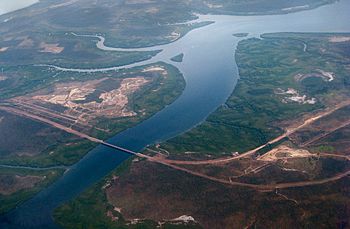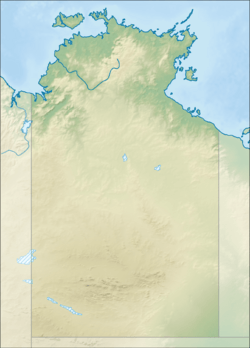Elizabeth River (Northern Territory) facts for kids
Quick facts for kids Elizabeth |
|
|---|---|

The Elizabeth River Bridge across Elizabeth River, upstream the East Arm of Darwin Harbour
|
|
|
Location of the Elizabeth River mouth in the Northern Territory
|
|
| Country | Australia |
| Territory | Northern Territory |
| Physical characteristics | |
| Main source | Noonamah, Northern Territory, Australia 35 m (115 ft) |
| River mouth | East Arm, Australia 0 m (0 ft) 12°32′31″S 130°58′55″E / 12.54194°S 130.98194°E |
| Length | 28 km (17 mi) |
The Elizabeth River is a river in the Northern Territory of Australia. It flows into Darwin Harbour, which is very close to the city of Darwin.
Where the River Flows
The Elizabeth River starts south of a place called Noonamah. From there, it flows towards the northwest. It crosses the Stuart Highway south of Humpty Doo.
The river then moves through an area where fresh water mixes with sea water. This is called an estuarine area. Finally, it empties into the East Arm of Darwin Harbour. From there, its waters reach Beagle Gulf and eventually the Timor Sea.
The Elizabeth River shares its water collection area with the Finniss River and the Howard River. Together, these rivers collect water from a large area of about 8,672 square kilometres (3,348 sq mi).
Weather in the Region
The area around the Elizabeth River has a special kind of weather called a monsoon tropical climate. This means it has two main seasons: the Dry season and the Wet season.
The Dry season lasts for six months, from April to September. During this time, there is not much rain, only about 24 millimeters (about 1 inch) on average each month.
The Wet season is from October to March. This is when most of the rain falls, with an average of 254 millimeters (about 10 inches) per month. Most of this rain happens between December and April. The amount of water flowing off the land can be between 250 and 1000 millimeters.
The most water flows in the Elizabeth River in February, with about 389 million liters per day. After February, the water flow slowly decreases. By July, almost no fresh water flows into Darwin Harbour until the next Wet season begins. Cyclones, which are like big storms, do not happen very often in this area.
The Finniss, Elizabeth, and Howard Rivers together release about 3,000 billion liters of water each year.
River Water Quality
In 2011, experts from the Northern Territory Government checked the water quality in the upper part of the river where it meets the sea. They found that the water was in excellent condition. The water quality in the freshwater parts of the river was also very good in 2011.
What the Land is Made Of
The ground beneath the Elizabeth River is mostly made of rocks called Permian siltstones and sandstones. These are types of rocks that formed a very long time ago.


